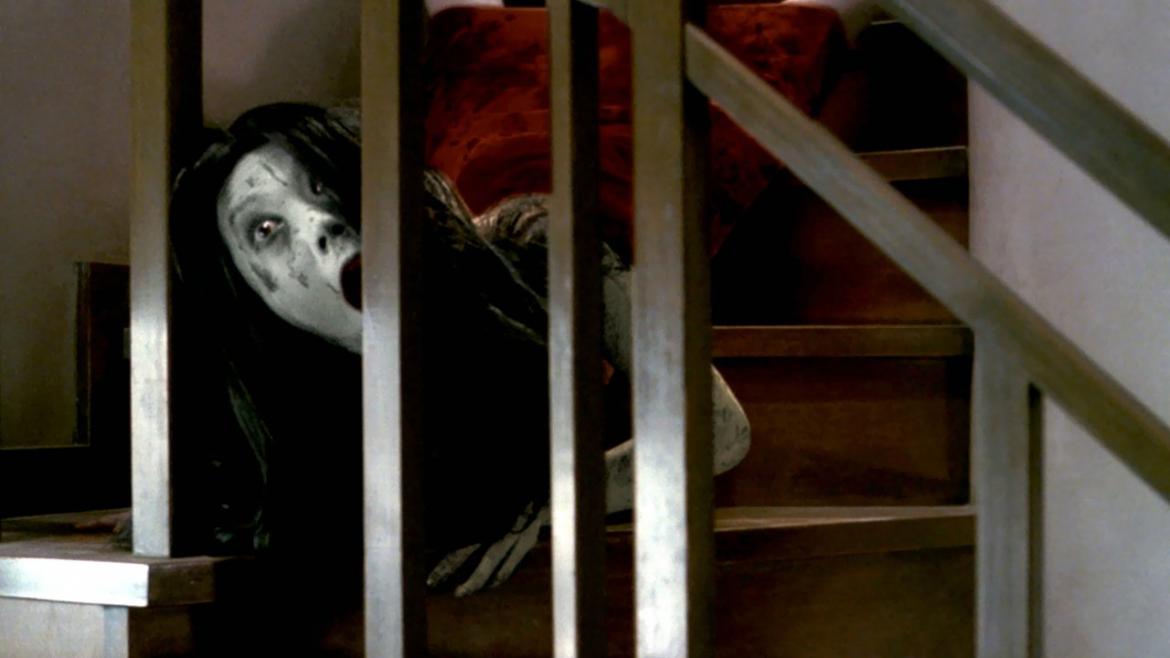
Ju-On: The Grudge (Movie Review)
Ju-On: The Grudge is the third film in Takashi Shimizu’s iconic franchise about a family of vengeful spirits, but it’s the first one to be released theatrically. Missed the first two installments (Ju-On: The Curse and Ju-On: The Curse 2)? Don’t panic. The events depicted here were used as the launching point for the American version of the series, making this as good of a place to join the series as any.
The film is divvied up into six segments, its story unfolding in a non-linear fashion over multiple years. The story opens with a man named Takeo murdering his wife Kayako when he suspects her of infidelity. The couple’s son Toshio and Takeo himself also both end up dead, though the cause isn’t spelled out. It’s revealed that Takeo’s actions have created a powerful curse and soon the new inhabitants of his former home are being tormented by ghostly visions of the deceased family. However, the curse isn’t content to just stay put. It spreads like a virus to anyone who enters the home. Wherever a person infected with the curse dies, a new version of the curse is born, until it reaches near-epidemic proportions.
If you were to make a list of all of the things that made for a great Asian ghost story in the early aughts, most of those elements would be found in Ju-On. We’ve already mentioned curses and vengeance, but what about a ghostly white specter with long dark hair? There’s one of those in Ju-On. Psychic phenomenon? Check. Creepy technology-inspired scares? Check.
Even though all of those reliable elements are present, the way Ju-On utilizes them doesn’t always work. For example, the film includes the trope of distorted photographs indicating someone has been targeted by the supernatural. It’s a great gimmick but it’s a throw-away in Ju-On. It comes up in only one segment and it doesn’t tell us anything we didn’t already know. The film also includes an extrasensory-perception angle (blended with some time-travel of all things) that serves to explain something that doesn’t need to be, i.e., why someone got scared and ran out of a haunted house. These elements do little to serve the plot and their inclusion feels almost compulsory.
The highly-virulent nature of the curse opens the doors to almost boundless possibilities. The thing is, Ju-On sticks to strains of the curse which emanate from Takeo’s cursed home, covering the new residents, their family members, a caretaker, and a few others. The caretaker in particular comes up again and again, surviving numerous brushes with the ghosts and getting saddled with a rather unsatisfying subplot about fate. The scope of the curse isn’t shown until the film’s closing moments. While this works as a nice twist, it may have felt more earned had the film bothered to investigate some of the other avenues the curse had taken instead of revisiting this one character (and location) over and over.
Shortcomings aside, the film’s atmosphere is sensationally chilling. Shimizu and his team turn in a virtuoso performance in tension-building. The most effective method they have at their disposal is sound. Each of the film’s three spirits has their own signature sound to indicate their presence – Takeo’s is a high-pitched hum, Toshio’s is a meow and, most disturbing of all, Kayako’s arrival is preceded by a throaty death rattle. Не смотря на запрет, онлайн казино продолжают развиваться и ярким примером этому является Slot V https://slotv-casino.su игорное заведение уже давно зарекомендовало себя на рынке и продолжает привлекать новых пользователей из Росиии и стран СНГ. The film uses each of these sounds, particularly the death rattle, and others, to keep viewers unnerved.
Ju-On: The Grudge is a classic in a number of ways, but it also isn’t perfect. Shimizu keeps throwing ideas into the mix until he runs out of runtime. His efforts are admirable and the success of this franchise is a testament to his talent and the connection audiences have with his characters. However, it’s impossible to shake the feeling that had he nixed certain elements and explored others more fully, Ju-On: The Grudge would be an even stronger film.

